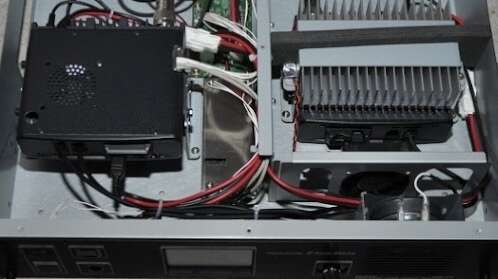The stock coax jumpers appear to be LMR-240 or RG-8 and we hoped to reduce loss by running LMR-400 feedline through the hole in the chassis all the way to the radios.
How Repeaters Work
Repeaters include two or more radios that simultaneously receive and retransmit radio transmissions. They are often connected to antennas that are positioned on towers, buildings or a mountain top, and can be used by licensed operators to extend the range of communications.
The simplest repeaters are mobile and portable transceivers with cross-band repeat capability. That means they can receive on one band and simultaneously retransmit on another band. Park a vehicle, preferably at a high elevation, enable cross-band repeat on the mobile radio and carry handy talkies as you hike the surrounding areas.
Examples include:
YAESU FTM-300DR
Icom IC-2730A
Anytone AT-3318UV-E Triband 144/220/440 HT
Some commonly-used repeaters, like the Yaesu DR-1, include two mobile radios and a controller that activates the transmit radio when the squelch opens on the receive radio.

This is what it looks like inside the Yaesu DR-1 repeater that has been deployed at countless repeater sites. It's essentially two mobile radios, a controller and a few other components bolted into a 19 inch rack mountable chassis.
WA5JRS 448.775 Mansfield Repeater
I had the opportunity to help with maintenance of the 448.775 repeater in Mansfield on Feb 18, 2017. While Jim KB0DBJ and Kim K3JAR climbed to the top of the water tower, Steve KM5HT, Bill KF5YIV and Dave KD5DK worked on improving the feedline to the radios in the Yaesu DR-1X repeater. The stock coax appears to be LMR-240 or RG-8 and the reception was significantly improved by running LMR-400 all the way to the radios.
We removed the stock coax jumpers and the reception was significantly improved by running LMR-400 all the way to the radios.
Here you can see the LMR-400 passing through the hole in the chassis to the TX radio inside the DR-1X repeater.
Steve KM5HT is connecting LMR-400 feedline directly to the RX radio in the repeater.
This is the relay that cuts power if the appropriate DTMF tones are sent to the control radio
This is the control radio and power supply for the repeater
These are the cavity filters that serve as the duplexer. Each notch filter is carefully tuned to allow only narrow transmit or receive frequencies to pass so that the transmitting and receiving radios can share the same antenna with minimal desense.
This is what it looks like inside the water tower looking up.
This is an image that I captured from my drone near the top of the water tower using my drone.
Linked Repeater Systems
These systems are available for use by licensed amateur radio operators in the Dallas Fort Worth and North Central Texas area.
W5EBQ Repeater System on the Dallas Green Building
52.59, 146.7 and 441.925 FM repeaters are linked together and have wide-area coverage due to the height of the building.
N6LXX repeater system
53.13 and 443.7375 FM repeaters are located on a 1500 foot tower in Rosston, TX with wide-area coverage. When propagation opens up on 6 meters the system is able to link to repeaters located in TX, CA, NV, CO
North Central Texas Connection
NCTC is a repeater system with linked radios that are spread across North Central Texas (and beyond). The UHF and VHF repeaters are mostly linked using RF link radios, but some internet links are sometimes connected via AllStat, DMR, Wires-X and EchoLink. The primary objective is to provide communications between the National Weather Service in Fort Worth and SKYWARN storm spotters during times of inclement weather. Sometimes other linked repeater systems are added during severe weather, state emergency drills, training nets and special occasions. Other affiliated systems include: FLG ETECS ERS NESTxLINK N5OAK
W5DFW - Republic of Texas Repeater System
The W5DFW repeater on 29.66 FM is linked to several UHF remote base repeaters in the DFW area. A link to Internet Archive is used because the w5dfw.org server is misbehaving. I recommend scanning all listed frequencies for occasional DX and other fascinating traffic.